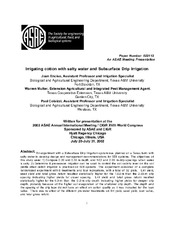| dc.description.abstract | An experiment with a Subsurface Drip Irrigation system was planned on a Texas farm with salty water to develop design and management recommendations for SDI systems. The objectives of this study were: 1) Compare 0.20 and 0.30 m depth, and 1.02 and 2.03 m drip spacings when water is salty. 2) Determine if pre-season irrigation can be used to control the soil salinity level on the soil profile when deficit irrigation is practiced on SDI systems. The experiment consisted of a complete randomized experiment with 8 treatments and four replications, with a total of 32 plots. Lint yield, seed yield and total gross return resulted statistically higher for the 1.02-m than the 2.03-m drip spacing indicating higher yields for closer spacing. Lint yield and total gross return resulted statistically higher for the 0.3-m than the 0.2-m drip depth indicating higher yields for deeper drip depth, probably because of the higher soil evaporation of the shallower drip depth. The depth and the spacing of the drip tape did not have an effect on cotton quality as it was indicated for the loan value. There was no effect of the different pre-water treatments on lint yield, seed yield, loan value, and total gross return. | en |


